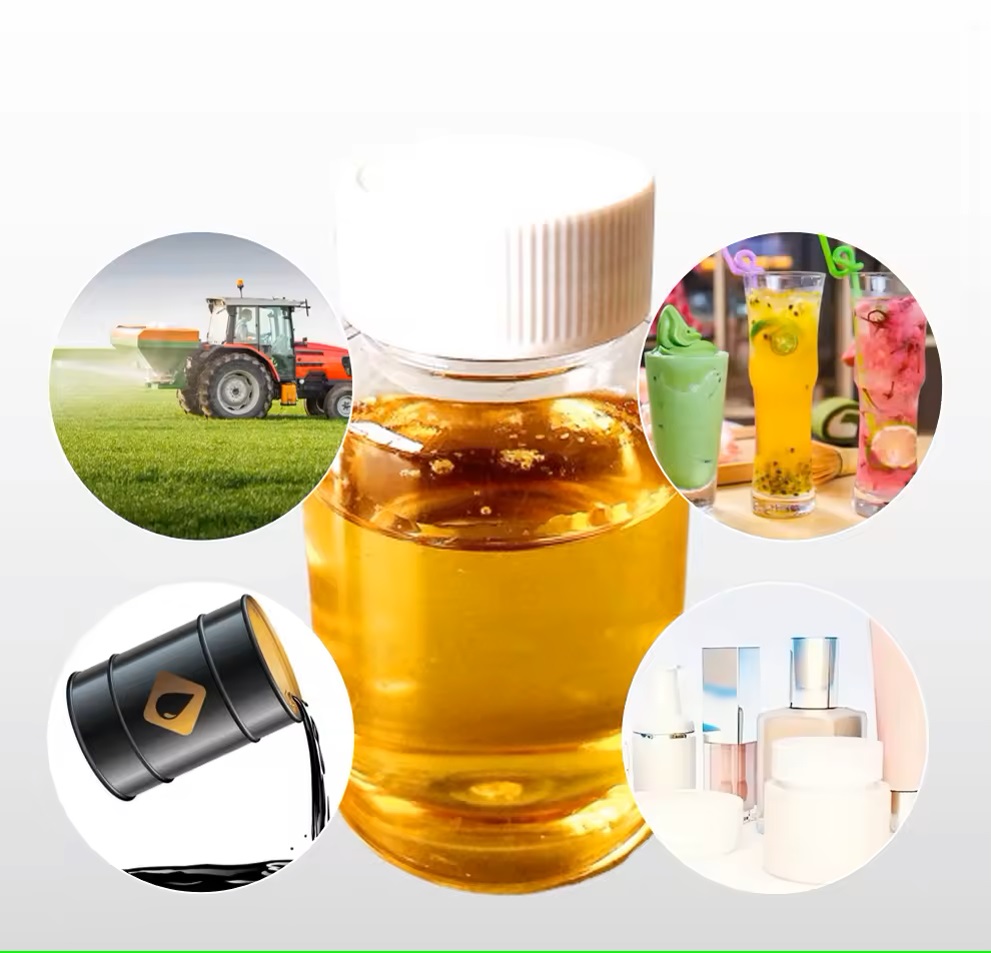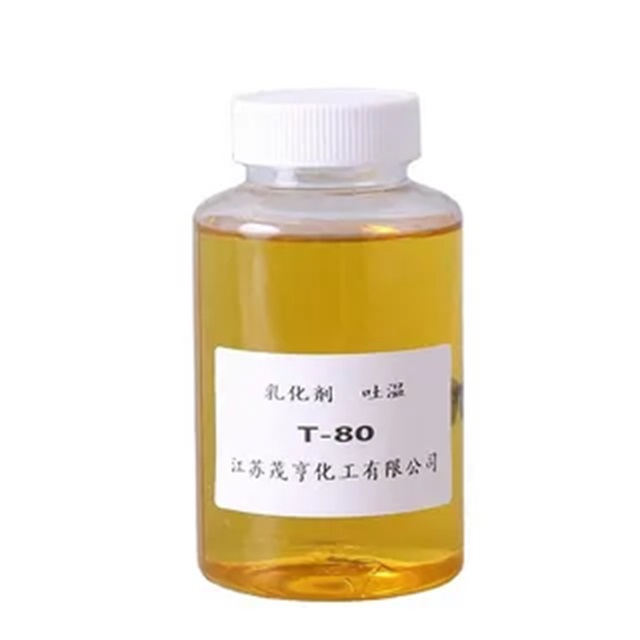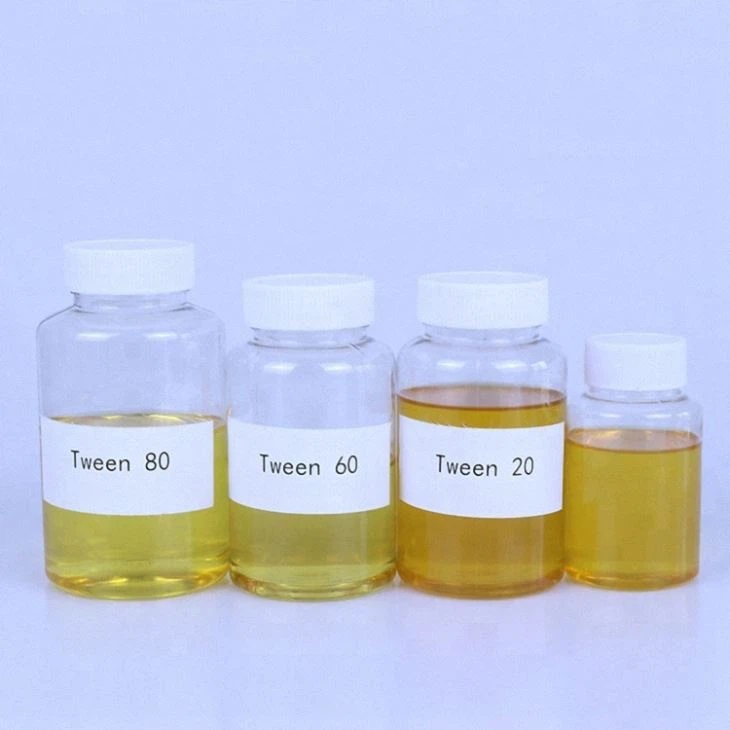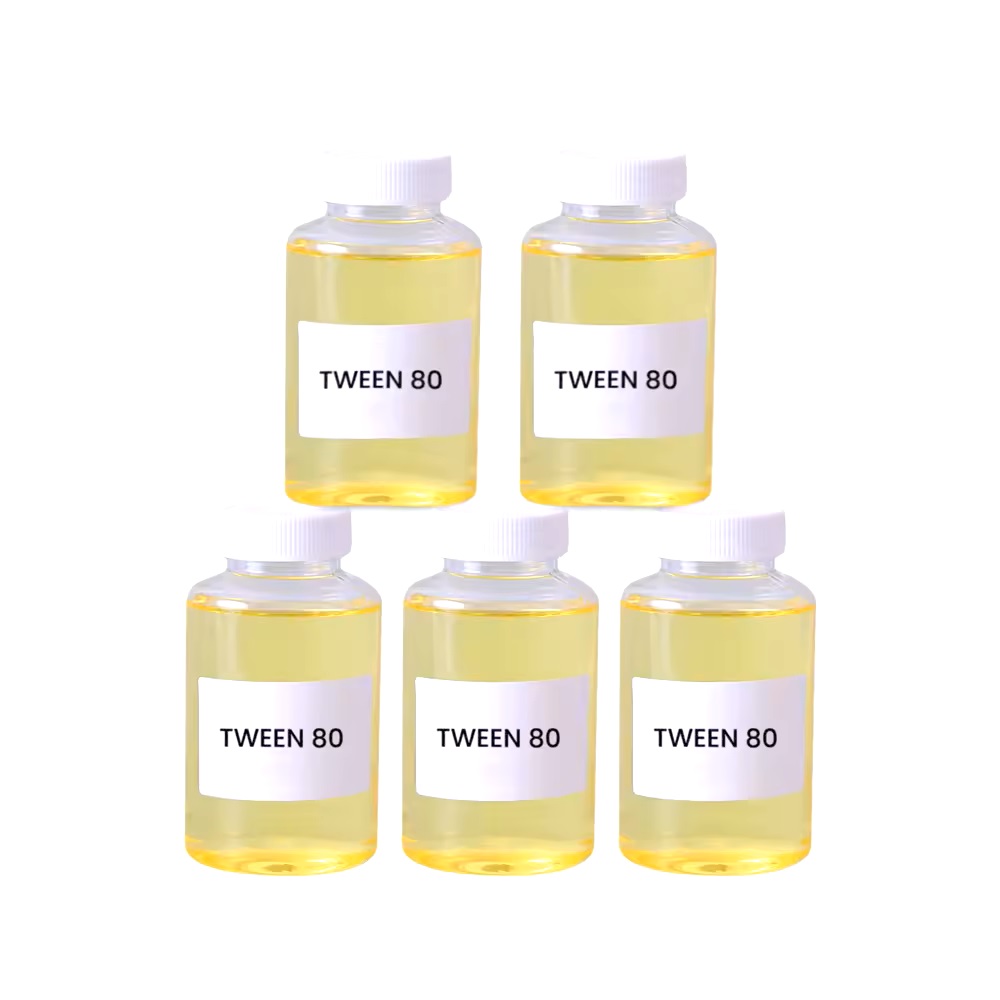We unleash your business potential by maximize the business innovation.
Send EmailE433, Tween(R) 80 , Tween-80, atlox1087, Emulsifier T-80, Sorbitan monooleate ethoxylate, Polyoxyethylenesorbitan monooleate, 9005-65-6
Tween(R) 80
CAS: 9005-65-6
Molecular Formula: C24H44O6
Names and Identifiers
| Name | Tween(R) 80 |
| Synonyms | Tween 80 Tween-80 Tween 81 Tween-81 atlox1087 atlox8916tf Tween(R) 80 armotanpmo-20 Emulsifier T-80 Emulsifier T-81 Sorbitan monooleate ethoxylate CHROMOGENIC SELECTIVE E.COLI 55MM Polyoxyethylenesorbitan monooleate TWEEN(R) 80 Vetec(TM) reagent grade CCA COLIFORMS CHROMOGENIC A. (ISO) 55MM 3,6-anhydro-2,4,5-tris-O-(2-hydroxyethyl)-1-O-{2-[(9E)-octadec-9-enoyloxy]ethyl}hexitol |
| CAS | 9005-65-6 |
| EINECS | 500-019-9 |
| InChI | InChI=1/C185H368O86/c1-2-3-4-5-6-7-8-9-10-11-12-13-14-15-16-17-18-22-270-271-179-175-264-169-165-259-159-155-254-149-145-249-139-135-244-129-125-239-119-115-234-109-105-229-99-95-224-89-85-219-80-81-220-90-91-225-100-101-230-110-111-235-120-121-240-130-131-245-140-141-250-150-151-255-160-161-260-170-171-265-180-182(266-176-172-261-166-162-256-156-152-251-146-142-246-136-132-241-126-122-236-116-112-231-106-102-226-96-92-221-86-82-216-77-74-213-71-68-210-65-62-207-59-56-204-53-50-201-47-44-198-41-38-195-35-32-192-29-26-189-23-19-186)185-184(268-178-174-263-168-164-258-158-154-253-148-144-248-138-134-243-128-124-238-118-114-233-108-104-228-98-94-223-88-84-218-79-76-215-73-70-212-67-64-209-61-58-206-55-52-203-49-46-200-43-40-197-37-34-194-31-28-191-25-21-188)183(181-269-185)267-177-173-262-167-163-257-157-153-252-147-143-247-137-133-242-127-123-237-117-113-232-107-103-227-97-93-222-87-83-217-78-75-214-72-69-211-66-63-208-60-57-205-54-51-202-48-45-199-42-39-196-36-33-193-30-27-190-24-20-187/h9-10,182-188H,2-8,11-181H2,1H3/b10-9+ |
Physico-chemical Properties
| Molecular Formula | C24H44O6 |
| Molar Mass | 428.600006103516 |
| Density | 1.08g/mLat 20°C |
| Melting Point | -25 °C |
| Boling Point | >100°C |
| Flash Point | >230°F |
| Water Solubility | 5-10 g/100 mL at 23 ºC |
| Vapor Presure | <1 mm Hg ( 20 °C) |
| Appearance | Bright yellow liquid |
| Specific Gravity | 1.080 (25/4℃) |
| Color | Amber |
| Merck | 14,7582 |
| PH | 5-7 (50g/l, H2O, 20℃) |
| Storage Condition | -20°C |
| Sensitive | Sensitive to light |
| Refractive Index | n20/D 1.473 |
| MDL | MFCD00082107 |
| Physical and Chemical Properties | Light yellow to amber oily viscous liquid. Relative density (25/4 ℃)1.06-1.10, refractive index 1.4756. Viscosity 0.4-0.7 s(25 °c), flash point 10 °c. Soluble in water, soluble in ethanol, vegetable oil, ethyl acetate, methanol, toluene insoluble in mineral oil. At low temperature into a gel, after heating recovery. She has extra odor and slightly bitter taste. |
| Use | This product is used as an emulsifier, dispersant, wetting agent, solubilizer, and stabilizer. It can be used as an antistatic agent in synthetic fibers and is an intermediate in chemical fiber oiling agents. |
Risk and Safety
| Hazard Symbols | Xi - Irritant |
| Risk Codes | R22 - Harmful if swallowed R36/37/38 - Irritating to eyes, respiratory system and skin. R37/38 - Irritating to respiratory system and skin. R41 - Risk of serious damage to eyes |
| Safety Description | S24/25 - Avoid contact with skin and eyes. S36/37/39 - Wear suitable protective clothing, gloves and eye/face protection. S36 - Wear suitable protective clothing. S26 - In case of contact with eyes, rinse immediately with plenty of water and seek medical advice. |
| WGK Germany | 1 |
| RTECS | WG2934000 |
| FLUKA BRAND F CODES | 3 |
| TSCA | Yes |
| HS Code | 34021300 |
| Toxicity | LD50 in mice, rats (ml/kg): 7.5, 6.3 i.p. (Varma) |
Standard
This strain of Sorbitan oleate and ethylene oxide polymerization of polyoxyethylene 20 Sorbitan oleate.
Trait
Authoritative Data Verified Data
- This product is a light yellow to orange-yellow viscous liquid, with slight odor, slight bitterness and astringent taste, with warm feeling.
- This product is soluble in water, ethanol, methanol or ethyl acetate, and is very slightly soluble in mineral oil.
relative density
The relative density of this product (General 0601) is 1.06~1.09.
viscosity
The kinematic viscosity of this product (General rule 0633 first method) is 2.0~2.5/s at 25°C (capillary inner diameter is 350~550).
acid value
Take 10g of this product, weigh it accurately, put it in 250ml Erlenmeyer flask, add 50ml of neutral ethanol (neutral to phenolphthalein indicated solution) to dissolve, add reflux condenser to boil for 10 minutes, and let it cool, add phenolphthalein indicator solution 5 drops, with sodium hydroxide titration solution (0.lmol/L) titration, acid value (General 0713) should not exceed 2.0.
saponification value
The saponification value of this product (General 0713) is 45~55.
hydroxyl value
The Hydroxyl value of this product (General 0713) is 65~80.
iodine value
The iodine value of this product (General 0713) is 18~24.
perchlorination value
The peroxide value of this product (General rule 0713) shall not exceed 10.
Differential diagnosis
- take 5ml of aqueous solution (l420) of this product, add 5ml of sodium hydroxide solution, boil for several minutes, let cool, acidify with dilute hydrochloric acid, and show milky white turbidity.
- take the aqueous solution of this product (1-20 ), drop the bromine test solution, the bromine test solution will fade.
- take 6ml of this product, add 4ml of water and mix well to form a gel.
- take 10ml of aqueous solution (1-20) of this product, add 5ml of cobalt ammonium thiocyanate solution (take 17.4g of cobalt ammonium thiocyanate and 2.8g of cobalt nitrate, add water to dissolve 100ml), mix well, then 5ml of trimethyl methane was added and mixed with shaking. After the mixture was allowed to stand, the chloroform layer showed blue color.
Exam
Authoritative Data Verified Data
pH
take 0.50g of this product, Add 10ml of water to dissolve, and measure according to law (General rule 0631). The pH value should be 5.0~7.5.
Color
take 10ml of this product, and compare with the same volume of control solution (take 8.0 ml of potassium dichromate solution for color comparison and 0.8ml of cobalt chloride solution for color comparison, add water to 10ml).
ethylene glycol and diethylene glycol
take about 4g of this product, precision weighing, 100ml measuring flask, precision plus internal standard solution (take 1, 3-butanediol appropriate amount, prepare a solution containing about 4mg per 1 ml of acetone) 1 ml, dilute to the scale with acetone, shake well, and use as a test solution; Take ethylene glycol and diethylene glycol, each about 40mg, precision weighing, in the same 100ml measuring flask, dilute to the scale with acetone, shake well, take 10ml and put it in another 100ml measuring flask, add 1 ml of internal standard solution and dilute to the scale with acetone, shake well as a control solution. Test according to Gas chromatography (General 0521). With 50% phenyl-50% methyl polysiloxane as the fixing liquid (column length 30m, inner diameter 0.53, membrane thickness l.Oum), the starting temperature is 40°C, the temperature is raised to 60°C at a rate of 1CTC per minute, and after 5 minutes, the temperature is raised to 170°C at a rate of 10°C per minute, the temperature was then increased to 280°C at a rate of 15°C per minute for 60 minutes (adjustable on a case-by-case basis). The inlet temperature was 270°C and the detector temperature was 290°C. Take the reference solution as the system suitability test solution, the separation degree between peaks shall not be less than 2.0, and the tailing factor of each peak shall meet the requirements. Measure the lul of the test solution and the reference solution, respectively, and record the chromatogram. Based on the peak area calculated by internal standard method, ethylene glycol and diethylene glycol shall not exceed 0.01%.
ethylene oxide and dioxane
take this product about lg, precision weighing, top empty bottle, precision plus ultrapure water l.oml, sealed, shake, as a test solution; Precision take the appropriate amount of ethylene oxide reference stock solution, set the flask, plus the treated polyethylene glycol 400 (at 60°C, rotary evaporation at 1.5 to 2.5kPa for 6 hours to remove volatile components) was dissolved and diluted to prepare a solution containing about 1 μg per 1 ml as an ethylene oxide reference solution. Separately take the right amount of dioxane, precision weighing, made of water containing about 10ug per lml of the solution, as dioxane
Control solution. Take about 1g of this product, precision weighing, top empty bottle, precision plus ethylene oxide reference solution and dioxane reference solution of 0.5, sealed, shake. As a control solution. Add 0 .5ml of ethylene oxide reference solution into the headspace bottle, add 0.1ml of newly prepared 0.001% acetaldehyde solution and 0 .5ml of dioxane reference solution, seal and shake. As a system suitability test solution. Test according to Gas chromatography (General 0521). With polydimethylsiloxane as the stationary liquid, the initial temperature is 35C, the temperature is maintained for 5 minutes, the temperature is raised to 180°C at a rate of 5°C per minute, and then the temperature is raised to 230°C at a rate of 30°C per minute, maintain 5 minutes (can be adjusted according to the specific situation). The inlet temperature was 150°C and the detector temperature was 250°C. The Headspace equilibrium temperature is 70°C, and the equilibrium time is 45 minutes. The system suitability test solution is sampled in the headspace, the flow rate is 2.5ml per minute, and the split ratio is 1:20. Adjust the sensitivity of the instrument so that the peak height of ethylene oxide peak and acetaldehyde peak is 15% of the full scale, the separation degree of acetaldehyde peak and ethylene oxide peak is not less than 2.0, and the height of dioxane peak should be at least 5 times of the baseline noise. The test solution and the reference solution were respectively injected in Headspace, and the injection was repeated for at least 3 times. The relative standard deviation of the peak area of ethylene oxide should not exceed 15%, and the relative standard deviation of the peak area of dioxane should not exceed 10%. Calculated by Standard addition method, containing no more than 0.0001% of ethylene oxide and no more than 0.001% of dioxane.
Freezing test
take this product, place it in a glass container, place it at 5°C 2°C for 24 hours, and do not freeze.
moisture
take this product, according to the moisture determination method (General 0832 first method 1), the water content shall not exceed 3.0%.
ignition residue
This product l.O g, inspection according to law (General 0841), residue shall not exceed 0.2%.
Heavy metals
The residue left under the item of taking the ignition residue shall not contain more than 10 parts per million of heavy metal when examined by law (General Principles 0821, Law II).
arsenic salt
take this product l.Og, put in a Kjeldahl Flask, add 5ml of sulfuric acid, digest with small fire to carbonize, control the temperature not to exceed 120°C (sulfuric acid can be added if necessary, the total amount is not more than 10ml), carefully add concentrated hydrogen peroxide solution Dropwise, once the reaction is stopped, continue heating, and add concentrated hydrogen peroxide solution Dropwise until the solution is colorless, cool, add 10ml of water, and evaporate until thick smoke occurs to remove hydrogen peroxide, add hydrochloric acid 5ml and water appropriate amount, according to the law inspection (General Principles 0822 The first law), should comply with the provisions (not over 0.0002%).
fatty acid composition
take about 0.lg of this product, accurately weigh, put it in a 50ml Erlenmeyer flask, add 2ml of 2% sodium hydroxide methanol solution, place it in a 65°C water bath, heat and reflux for 30 minutes, and let it cool, add 2ml of 14% methanol solution of boron trifluoride, heat and reflux in a water bath for 30 minutes, cool, add 4ml of n-heptane, continue heating and reflux in the water bath for 5 minutes, cool, add 10ml of saturated gasification sodium solution, shake, the mixture was allowed to stand to separate into layers, and the upper layer was taken and washed 3 times with 4ml of water each time. The upper layer was dried over anhydrous sodium sulfate and used as a test solution. According to gas chromatography (through
0521) test. Quartz capillary column with polyethylene glycol -20m as stationary liquid (0. 2mmx30m, membrane thickness 0.50Mm) for the column, the initial temperature is 90°C, at the rate of 20°C per minute to 160°C, for 1 minutes, the temperature was then increased to 220°C at a rate of 2°C per minute for 20 minutes; The inlet temperature was 190°C; And the detector temperature was 250°C. Weigh appropriate amount of methyl myristate, methyl palmitate, methyl palmitate, methyl stearate, methyl oleate, methyl linoleate and methyl linolenic acid respectively, add n-heptane to dissolve and prepare about 1 mg solution per lm, and inject lul into gas chromatograph, record the chromatogram, the number of theoretical plate is not less than 10000 according to the peak of methyl oleate, and the resolution of each chromatographic peak should meet the requirements. The sample solution lul is injected into the gas chromatograph, the chromatogram is recorded, and calculated by area normalization method (the peak area less than 0.05% is negligible), The oleic acid shall not be less than 58.0%, containing myristic acid, palmitic acid, palmitoleic acid, stearic acid, linoleic acid and linolenic acid were not more than 5.0%, 16.0%. 8.0%, 6.0%, 18.0% and 4.0%.
Category
pharmaceutical excipients, solubilizers and emulsifiers.
Storage
light shielding, sealed storage.
Preparation method
Preheat x (mol) Span-80 and put it into a reaction kettle. Stir it up and add a catalyst amount of alkaline solution. Vacuum dehydration is carried out, and after the dehydration is completed, nitrogen is used to replace the air in the kettle. When the temperature rises to 140 ℃, 20x (mol) of ethylene oxide is added, and gradually the temperature rises to 180-200 ℃. After passing through the epoxy ethane, continue the reaction for 1 hour, then cool down, and pour the material into the neutralization kettle to neutralize with acetic acid until the acid value is 2-2.2 as the endpoint. Then decolorize with an appropriate amount of hydrogen peroxide, dehydrate at 110~120 ℃ for 5 hours, and measure that the moisture content is less than 3% as the endpoint. The cooling discharge packaging is the finished product.
Introduction
Tween (R) 80 is a non-ionic surfactant with the chemical name polyethylene glycol ether. It is a polyoxyethylene compound with good emulsifying properties and surface activity.
Tween 80 has the following properties:
-Appearance: A viscous liquid ranging from yellow to yellow brown in color
-Solubility: easily soluble in water and most organic solvents
-Stability: It has good stability and can maintain stability in both acidic and alkaline environments
The main uses of Tween 80 include:
-As an emulsifier and stabilizer, it is widely used in the preparation of lotion, emulsions and sprays
-Used as a surfactant in cell culture and biomedical research
Tween 80 system:
The preparation of Tween 80 mainly involves esterification of sorbitol with stearic acid, followed by epoxidation with a certain amount of ethylene oxide.
The security of Tween 80:
Tween 80 is recognized by the FDA as a generally safe substance and is generally considered relatively safe. However, attention should still be paid to situations such as allergic reactions and skin irritation. Correct operating methods and dosage control should be followed during use to ensure safety.



